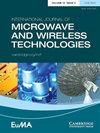使用兆瓦级微波技术的大功率岩石粉碎应用器
IF 1.3
4区 计算机科学
Q3 ENGINEERING, ELECTRICAL & ELECTRONIC
International Journal of Microwave and Wireless Technologies
Pub Date : 2024-03-21
DOI:10.1017/s1759078724000308
引用次数: 0
摘要
采矿业在很大程度上依赖于能源密集型工艺,如岩石破碎,这导致了巨大的运营成本。本文探讨了微波辅助破岩作为提高采矿业粉碎效率的创新方法。该系统采用最大输出功率为 7.5 兆瓦的 Klystron 微波电源,使用 3 GHz 的 $\mathrm{TM}_{010}$ 单模腔,将能量导入专门设计的岩石腔内。论文强调了为该系统设计高效微波腔体的重要性,重点介绍了腔体的设计和仿真。通过模拟结果(使用 HFSS 软件)和实验观察,研究揭示了微波技术在采矿领域的应用前景。设计腔体(S11)的模拟频率响应为 -22 dB,这表明它在降低能耗和相关成本方面具有巨大潜力。此外,设计的腔体由铝制成,并填充了聚醚醚酮材料。该空腔在 3 GHz 频率下的测量频率响应(S11)为 -17 dB。本文章由计算机程序翻译,如有差异,请以英文原文为准。
An applicator for high-power rock comminution using microwave technology in the megawatt range
The mining industry is heavily dependent on energy-intensive processes, such as rock breakage, which leads to significant operational costs. This paper explores microwave-assisted rock breakage as an innovative method to enhance the efficiency of comminution within the mining industry. It introduces a system that employs a Klystron microwave power source with a maximum output of 7.5 MW, using a $\mathrm{TM}_{010}$ single-mode cavity at 3 GHz, to channel energy inside a specially designed rock cavity. The paper emphasizes the importance of designing an efficient microwave cavity for this system, focusing on the cavity’s design and simulation. Through both simulated results (using HFSS software) and experimental observations, the study reveals the promising application of microwave technology in the field of mining. The simulated frequency response of the designed cavity (S 11 ) is −22 dB, it demonstrates significant potential for reducing both energy consumption and associated costs. Additionally, the designed cavity is fabricated from aluminum and filled with polyether ether ketone material. The measured frequency response (S 11 ) of the cavity at 3 GHz is −17 dB.
求助全文
通过发布文献求助,成功后即可免费获取论文全文。
去求助
来源期刊

International Journal of Microwave and Wireless Technologies
ENGINEERING, ELECTRICAL & ELECTRONIC-TELECOMMUNICATIONS
CiteScore
3.50
自引率
7.10%
发文量
130
审稿时长
6-12 weeks
期刊介绍:
The prime objective of the International Journal of Microwave and Wireless Technologies is to enhance the communication between microwave engineers throughout the world. It is therefore interdisciplinary and application oriented, providing a platform for the microwave industry. Coverage includes: applied electromagnetic field theory (antennas, transmission lines and waveguides), components (passive structures and semiconductor device technologies), analogue and mixed-signal circuits, systems, optical-microwave interactions, electromagnetic compatibility, industrial applications, biological effects and medical applications.
 求助内容:
求助内容: 应助结果提醒方式:
应助结果提醒方式:


